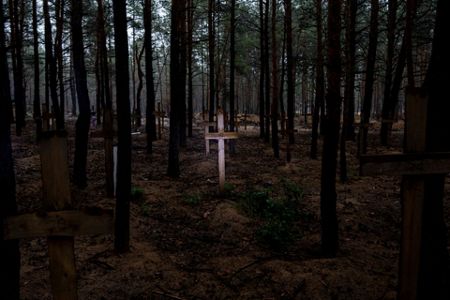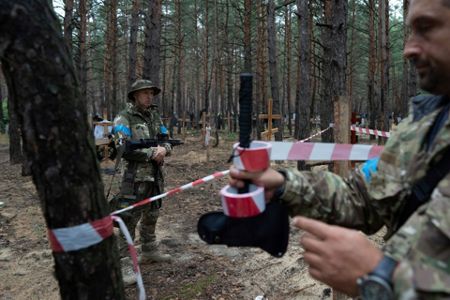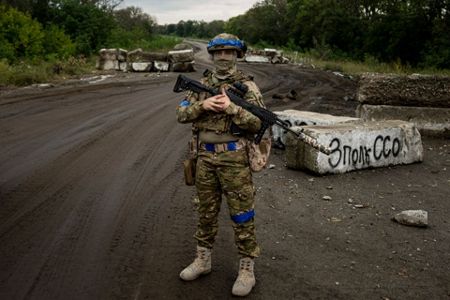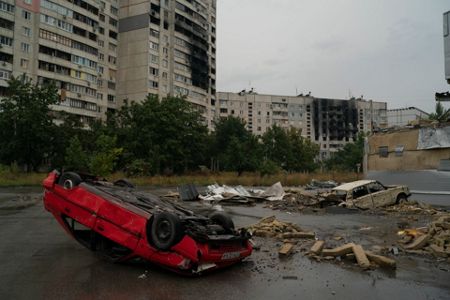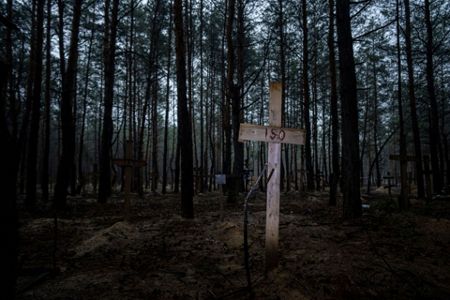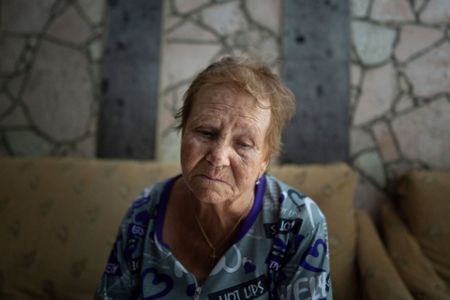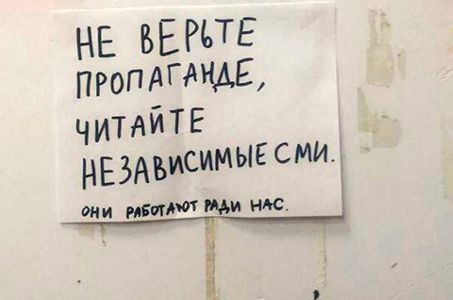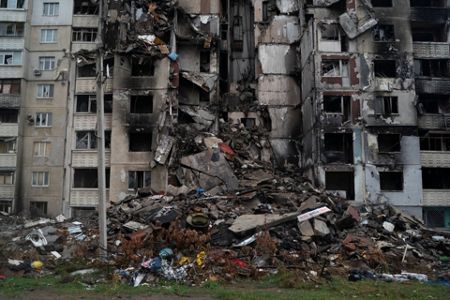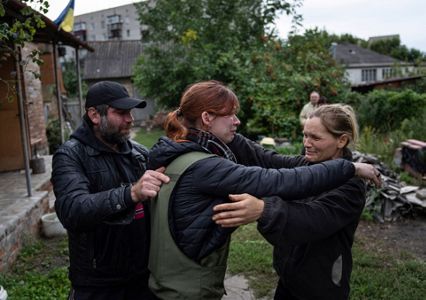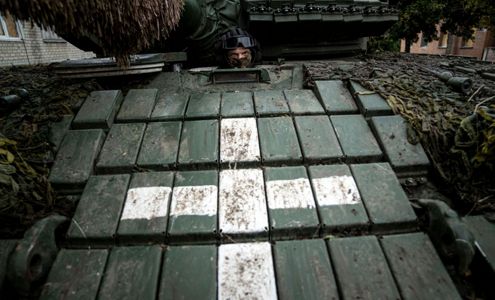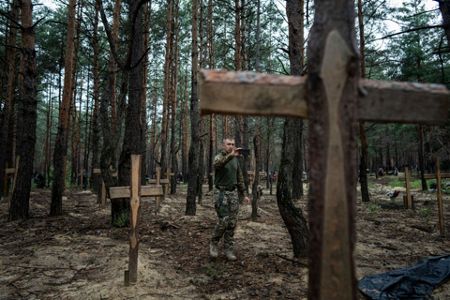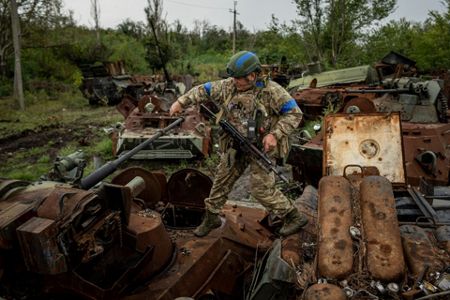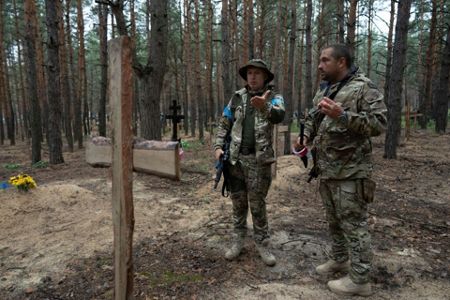IZIUM, Ukraine (AP) — Ukrainian President Volodymr Zelenskyy has cited evidence of atrocities in a mass burial site that has been found in an area recently freed of Russian occupation.
In an unusual special video, Zelenskyy said hundreds of people had been found “tortured, shot, killed by shelling” at the site in Izium. He cited evidence of atrocities such as a body with a rope around its neck and broken arms.
In the video, Zelenskyy says more than 400 graves have been found at the site but that the number of victims isn’t yet known. Zelenskyy, who visited the Izium area on Wednesday, said the discoveries showed again the need for world leaders to declare Russia a state sponsor of terrorism.
THIS IS A BREAKING NEWS UPDATE. AP’s earlier story follows below.
IZIUM, Ukraine (AP) — Ukrainian authorities unearthed bodies, some they said bore hallmarks of torture, from a mass burial site Friday in an area recently recaptured from Russian forces. President Volodymyr Zelenskyy cited the site as an example of “what the Russian occupation has led to.”
Digging in the rain, workers hauled body after body out of the sandy soil in a pine forest near Izium that police said contained 445 graves. Protected by full body suits and rubber gloves, they gently felt through the decomposing remains of their clothing, seemingly looking for things that might identify them.
Ukrainian forces got access to the site after recapturing the northeastern city and much of the wider Kharkiv region in a counteroffensive that suddenly shifted the momentum in the nearly seven-month war.
Some of the bodies had their hands tied behind their backs and ropes around their necks, said the region's chief prosecutor, Oleksandr Filchakov. Ukrainian officials said they also found evidence of torture elsewhere in the region.
Associated Press journalists who visited the site saw graves amid the pine trees, marked with simple wooden crosses. Most were numbered — and the count went into the 400s.
It was not clear who was buried under many of the dirt mounds or how all of them died. Witnesses and a Ukrainian investigator said some were shot and others were killed by artillery fire, mines or airstrikes. The U.N. human rights office said it would investigate the deaths.
The majority of the people buried were believed to be civilians, according to Ukrainian officials. But there was at least one mass grave, with a marker saying it contained the bodies of 17 Ukrainian soldiers.
In his nightly televised address on Thursday, Zelenskyy spoke about the site, invoking the names of other Ukrainian cities where authorities said retreating Russian troops left behind mass graves of civilians.
“Bucha, Mariupol, now, unfortunately, Izium,” he said. “Russia leaves death everywhere. And it must be held accountable for it.”
“We want the world to know what is really happening and what the Russian occupation has led to,” he said.
Elsewhere in Ukraine, the war continued to claim lives and wreak destruction.
— Ukraine’s presidential office said Russian shelling killed five civilians and wounded 18 others in a 24-hour span. Missile strikes were also reported, with Zelenskyy’s hometown of Kryvyi Rih among the targets for a third consecutive day Friday. Air raid sirens also howled in the capital, Kyiv.
— Ukraine’s counteroffensive gained more ground, and Ukrainian authorities claimed nearly all of the Kharkiv region is now in their control.
— More killings targeting pro-Russian separatist officials were reported in areas under their control. Separatist authorities said a blast killed the prosecutor-general of the self-proclaimed republic in the Luhansk region. Moscow-backed authorities said two Russian-installed officials were also killed in Berdyansk, a city in the Zaporizhzhia region occupied earlier in the war.
— To bolster the Ukrainian offensive, the Biden administration announced another $600 million package of military aid.
At the Izium burial site, the marking of individual graves with wooden crosses differed from some other sites discovered earlier in the war and seen by AP journalists — including some around Kyiv that are being investigated as sites of possible war crimes. Bodies found outside the capital in the town of Bucha and elsewhere after Russian forces withdrew had been dumped together and buried without markers.
Izium resident Sergei Gorodko said that among the hundreds buried in individual graves were dozens of adults and children killed in a Russian airstrike on an apartment building.
He said he pulled some of them out of the rubble “with my own hands.”
Sergei Bolvinov, a senior investigator for Ukrainian police, told British TV broadcaster Sky News that some of the people buried were shot, while others died from artillery fire, mines or airstrikes.
The mass grave of Ukrainian soldiers could contain more than the 17 bodies mentioned on its marker, said Oleg Kotenko, an official with the Ukrainian ministry tasked with reintegrating occupied territories.
“We haven’t counted them yet, but I think there are more than 25 or even 30,” he said, basing his estimate on video footage of the site that Russian soldiers posted on social media.
Ukraine’s national police chief, Ihor Klymenko, said about 445 graves had so far been found at the site and that the “majority” were believed to be civilians.
The work to determine what caused their deaths “is not a one-week job. These bodies have been buried there since March,” he said.
Before exhumation work began, investigators with metal detectors scanned the site for any hidden explosives. Soldiers strung red and white plastic tape between the trees to mark off parts of the site. A few graves had wreaths of flowers hanging from the crosses, and some bore people’s names.
Izium was a key supply hub for Russian forces until they withdrew in recent days. Izium city councilor Maksym Strelnikov told reporters in an online briefing from an undisclosed location this week that hundreds of people had died during the fighting and after Russia seized the town in March. Many couldn’t get a proper burial, he said.
His claims could not be immediately verified, but similar scenes have played out in other cities captured by Russian forces, including Mariupol.
Strelnikov said an untold number of people also died from lack of proper health care since the “medical infrastructure of the city was destroyed.” Most of the city’s pre-war population of 47,000 fled to Ukrainian-held territories. Strelnikov said 10,000 residents remain in the ruined city — bracing for more hardship with winter coming and most infrastructure destroyed.
The national police chief, Klymenko, said “torture chambers” have also been found in recaptured towns and villages of the Kharkiv region. The claim could not be independently verified.
Seven Sri Lankan students who fell into Russian hands in Kupiansk, also in the Kharkiv region, have also said that they were held and mistreated, he said.
“They are scared, they were abused,” he said. They include “a woman who can barely speak” and two with torn toe nails.
Ukrainian Deputy Interior Minister Yevhen Enin said bodies exhumed in the region also showed “traces of a violent death, but also of torture — cut off ears, etc. This is just the beginning.”
“All these traces of war crimes are now carefully documented by us. And we know from the experience of Bucha that the worst crimes can only be exposed over time,” Enin said in an interview with Ukraine’s Radio NV.
___
This story has been updated to correct that seven, not six, Sri Lankan students said they fell into Russian hands.
___
Associated Press journalists Hanna Arhirova and Jon Gambrell in Kyiv and Jamey Keaten in Geneva contributed reporting.
___
Follow AP war coverage at https://apnews.com/hub/russia-ukraine
Copyright 2022 The Associated Press. All rights reserved. This material may not be published, broadcast, rewritten or redistributed without permission.


